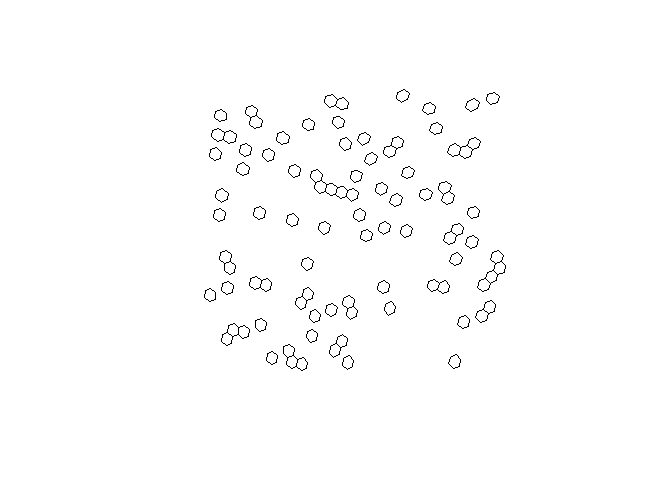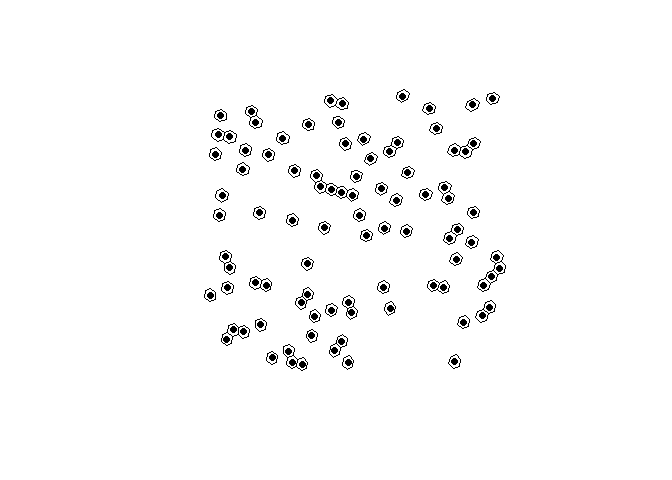

{h3o} is a lightweight R package for interacting with Uber’s H3 Geospatial Indexing
system. The R package uses extendr
to wrap the eponymous h3o Rust
crate, which offers a pure Rust implementation of H3, so no linking
to Uber’s H3 C library. The package is also intended to work with the {sf} package for
geometric operations and as a bonus represents the H3 class as {vctrs}, so they
work seamlessly within a tidyverse workflow.
You can install the release version of {h3o} from CRAN
with:
install.packages("h3o")Or you can install the development version from GitHub with:
# install.packages("pak")
pak::pak("extendr/h3o")H3 vectors can be created from POINT geometry columns
(sfc objects) defined by sf.
library(h3o)
library(dplyr)
library(sf)
library(tibble)
xy <- data.frame(
x = runif(100, -5, 10),
y = runif(100, 40, 50)
)
pnts <- st_as_sf(
xy,
coords = c("x", "y"),
crs = 4326
)
pnts |> mutate(h3 = h3_from_points(geometry, 5))
#> Simple feature collection with 100 features and 1 field
#> Geometry type: POINT
#> Dimension: XY
#> Bounding box: xmin: -4.906456 ymin: 40.13608 xmax: 9.720642 ymax: 49.77958
#> Geodetic CRS: WGS 84
#> First 10 features:
#> geometry h3
#> 1 POINT (6.604776 48.68961) 851f8423fffffff
#> 2 POINT (-0.6574923 40.42394) 85397237fffffff
#> 3 POINT (-4.327095 46.43766) 851843dbfffffff
#> 4 POINT (2.098711 40.28164) 85394283fffffff
#> 5 POINT (8.558989 44.79674) 851f9bd7fffffff
#> 6 POINT (-2.064705 47.93067) 8518637bfffffff
#> 7 POINT (7.966344 47.88122) 851f8143fffffff
#> 8 POINT (-1.18493 48.41385) 85186383fffffff
#> 9 POINT (0.2382595 43.76685) 8539668ffffffff
#> 10 POINT (0.2054317 48.94255) 85186573fffffffH3 vectors also have an st_as_sfc() method which allows
conversion of H3 cell indexes into sf POLYGONs.
# replace geometry
h3_cells <- pnts |>
mutate(
h3 = h3_from_points(geometry, 4),
geometry = st_as_sfc(h3)
)
# plot the hexagons
plot(st_geometry(h3_cells))
H3 cell centroids can be returned using h3_to_points().
If sf is avilable, the results will be returned as an
sfc (sf column) object. Otherwise it will return a list of
sfg (sf geometries).
# fetch h3 column
h3s <- h3_cells[["h3"]]
# get there centers
h3_centers <- h3_to_points(h3s)
# plot the hexagons with the centers
plot(st_geometry(h3_cells))
plot(h3_centers, pch = 16, add = TRUE, col = "black")
H3Edge vectors representing the boundaries of H3 cells
can be created with h3_edges(),
h3_shared_edge_pairwise(), and
h3_shared_edge_sparse().
cell_edges <- h3_edges(h3s[1:3])
cell_edges
#> [[1]]
#> <H3Edge[6]>
#> [1] 1141f843ffffffff 1241f843ffffffff 1341f843ffffffff 1441f843ffffffff
#> [5] 1541f843ffffffff 1641f843ffffffff
#>
#> [[2]]
#> <H3Edge[6]>
#> [1] 11439723ffffffff 12439723ffffffff 13439723ffffffff 14439723ffffffff
#> [5] 15439723ffffffff 16439723ffffffff
#>
#> [[3]]
#> <H3Edge[6]>
#> [1] 1141843dffffffff 1241843dffffffff 1341843dffffffff 1441843dffffffff
#> [5] 1541843dffffffff 1641843dffffffffWe’ve created a list of each cell’s edges. We can flatten them using
flatten_edges().
cell_edges <- flatten_edges(cell_edges)
cell_edges
#> <H3Edge[18]>
#> [1] 1141f843ffffffff 1241f843ffffffff 1341f843ffffffff 1441f843ffffffff
#> [5] 1541f843ffffffff 1641f843ffffffff 11439723ffffffff 12439723ffffffff
#> [9] 13439723ffffffff 14439723ffffffff 15439723ffffffff 16439723ffffffff
#> [13] 1141843dffffffff 1241843dffffffff 1341843dffffffff 1441843dffffffff
#> [17] 1541843dffffffff 1641843dffffffffThese can be cast to sfc objects using st_as_sfc().
st_as_sfc(cell_edges)
#> Geometry set for 18 features
#> Geometry type: LINESTRING
#> Dimension: XY
#> Bounding box: xmin: -4.577141 ymin: 40.10303 xmax: 6.908627 ymax: 48.92561
#> Geodetic CRS: WGS 84
#> First 5 geometries:
#> LINESTRING (6.828196 48.56718, 6.908627 48.78762)
#> LINESTRING (6.24713 48.62253, 6.49798 48.48486)
#> LINESTRING (6.49798 48.48486, 6.828196 48.56718)
#> LINESTRING (6.656859 48.92561, 6.325574 48.84283)
#> LINESTRING (6.908627 48.78762, 6.656859 48.92561)Additionally, you can get the vertexes of H3 cell indexes using
h3_to_vertexes() which returns an
sfc_MULTIPOINT.
h3_to_vertexes(h3s)
#> Geometry set for 100 features
#> Geometry type: MULTIPOINT
#> Dimension: XY
#> Bounding box: xmin: -5.162291 ymin: 40.02598 xmax: 10.1164 ymax: 50.08041
#> Geodetic CRS: WGS 84
#> First 5 geometries:
#> MULTIPOINT ((6.325574 48.84283), (6.24713 48.62...
#> MULTIPOINT ((-0.6690999 40.57641), (-0.9475784 ...
#> MULTIPOINT ((-4.227092 46.53696), (-4.535994 46...
#> MULTIPOINT ((1.905903 40.46739), (1.849434 40.2...
#> MULTIPOINT ((8.142693 44.78613), (8.062234 44.5...Since h3o is written in Rust, it is very fast.
h3_strs <- as.character(h3s)
bench::mark(
h3o = st_as_sfc(h3s),
h3jsr = h3jsr::cell_to_polygon(h3_strs)
)
#> # A tibble: 2 × 6
#> expression min median `itr/sec` mem_alloc `gc/sec`
#> <bch:expr> <bch:tm> <bch:tm> <dbl> <bch:byt> <dbl>
#> 1 h3o 462.6µs 505.7µs 1863. 9.85KB 14.6
#> 2 h3jsr 8.34ms 9.36ms 106. 2.7MB 90.0nc <- st_read(system.file("gpkg/nc.gpkg", package = "sf"), quiet = TRUE) |>
st_transform(4326) |>
st_geometry()
bench::mark(
h3o = sfc_to_cells(nc, 5, "centroid"),
h3jsr = h3jsr::polygon_to_cells(nc, 5),
check = FALSE
)
#> # A tibble: 2 × 6
#> expression min median `itr/sec` mem_alloc `gc/sec`
#> <bch:expr> <bch:tm> <bch:tm> <dbl> <bch:byt> <dbl>
#> 1 h3o 4.8ms 5.35ms 183. 21.4KB 11.3
#> 2 h3jsr 27.6ms 28.51ms 34.8 748.7KB 4.97bench::mark(
h3o = h3_from_points(pnts$geometry, 3),
h3jsr = h3jsr::point_to_cell(pnts$geometry, 3),
check = FALSE
)
#> # A tibble: 2 × 6
#> expression min median `itr/sec` mem_alloc `gc/sec`
#> <bch:expr> <bch:tm> <bch:tm> <dbl> <bch:byt> <dbl>
#> 1 h3o 103.4µs 123.3µs 7372. 848B 11.4
#> 2 h3jsr 2.63ms 3.04ms 326. 975KB 13.3bench::mark(
h3o = h3_edges(h3s),
h3jsr = h3jsr::get_udedges(h3_strs),
check = FALSE
)
#> # A tibble: 2 × 6
#> expression min median `itr/sec` mem_alloc `gc/sec`
#> <bch:expr> <bch:tm> <bch:tm> <dbl> <bch:byt> <dbl>
#> 1 h3o 403.5µs 530.3µs 1593. 848B 16.9
#> 2 h3jsr 1.64ms 1.76ms 555. 67.9KB 17.3# get edges for a single location
eds <- h3_edges(h3s[1])[[1]]
# strings for h3jsr
eds_str <- as.character(eds)
bench::mark(
h3o = h3_edge_cells(eds),
h3jsr = h3jsr::get_udends(eds_str),
check = FALSE
)
#> # A tibble: 2 × 6
#> expression min median `itr/sec` mem_alloc `gc/sec`
#> <bch:expr> <bch:tm> <bch:tm> <dbl> <bch:byt> <dbl>
#> 1 h3o 12.9µs 18.1µs 49775. 7.86KB 19.9
#> 2 h3jsr 631.3µs 740.1µs 1248. 19.82KB 12.9